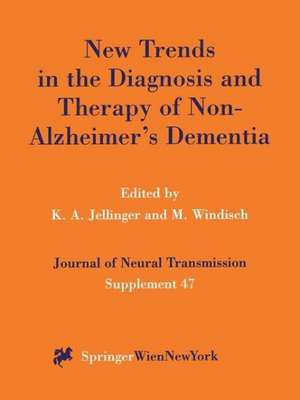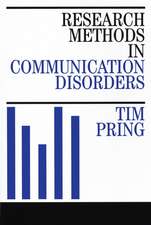New Trends in the Diagnosis and Therapy of Non-Alzheimer’s Dementia: Journal of Neural Transmission. Supplementa, cartea 47
Editat de Kurt A. Jellinger, Manfred Windischen Limba Engleză Paperback – 16 iul 1996
Din seria Journal of Neural Transmission. Supplementa
- 5%
 Preț: 1052.61 lei
Preț: 1052.61 lei - 5%
 Preț: 423.12 lei
Preț: 423.12 lei -
 Preț: 389.88 lei
Preț: 389.88 lei - 5%
 Preț: 360.86 lei
Preț: 360.86 lei - 5%
 Preț: 712.60 lei
Preț: 712.60 lei - 5%
 Preț: 365.61 lei
Preț: 365.61 lei -
 Preț: 379.68 lei
Preț: 379.68 lei - 5%
 Preț: 376.43 lei
Preț: 376.43 lei -
 Preț: 380.45 lei
Preț: 380.45 lei - 15%
 Preț: 665.73 lei
Preț: 665.73 lei - 5%
 Preț: 990.01 lei
Preț: 990.01 lei - 5%
 Preț: 368.73 lei
Preț: 368.73 lei - 5%
 Preț: 373.84 lei
Preț: 373.84 lei -
 Preț: 391.22 lei
Preț: 391.22 lei - 15%
 Preț: 643.34 lei
Preț: 643.34 lei -
 Preț: 381.59 lei
Preț: 381.59 lei - 5%
 Preț: 394.32 lei
Preț: 394.32 lei - 5%
 Preț: 374.78 lei
Preț: 374.78 lei -
 Preț: 397.97 lei
Preț: 397.97 lei - 5%
 Preț: 364.33 lei
Preț: 364.33 lei - 5%
 Preț: 372.97 lei
Preț: 372.97 lei - 5%
 Preț: 372.19 lei
Preț: 372.19 lei - 5%
 Preț: 387.02 lei
Preț: 387.02 lei - 5%
 Preț: 1371.73 lei
Preț: 1371.73 lei - 5%
 Preț: 382.06 lei
Preț: 382.06 lei - 5%
 Preț: 367.47 lei
Preț: 367.47 lei - 5%
 Preț: 698.36 lei
Preț: 698.36 lei - 18%
 Preț: 1400.35 lei
Preț: 1400.35 lei - 5%
 Preț: 1314.97 lei
Preț: 1314.97 lei - 5%
 Preț: 1428.71 lei
Preț: 1428.71 lei - 5%
 Preț: 1095.73 lei
Preț: 1095.73 lei - 5%
 Preț: 714.46 lei
Preț: 714.46 lei - 5%
 Preț: 1113.11 lei
Preț: 1113.11 lei - 5%
 Preț: 1015.42 lei
Preț: 1015.42 lei - 5%
 Preț: 719.74 lei
Preț: 719.74 lei - 5%
 Preț: 1381.89 lei
Preț: 1381.89 lei - 5%
 Preț: 1304.04 lei
Preț: 1304.04 lei - 5%
 Preț: 1980.17 lei
Preț: 1980.17 lei
Preț: 379.33 lei
Preț vechi: 399.29 lei
-5% Nou
Puncte Express: 569
Preț estimativ în valută:
72.58€ • 75.78$ • 60.07£
72.58€ • 75.78$ • 60.07£
Carte tipărită la comandă
Livrare economică 05-19 aprilie
Preluare comenzi: 021 569.72.76
Specificații
ISBN-13: 9783211828236
ISBN-10: 3211828230
Pagini: 300
Ilustrații: VIII, 288 p. 24 illus.
Dimensiuni: 210 x 279 x 16 mm
Greutate: 0.68 kg
Editura: SPRINGER VIENNA
Colecția Springer
Seria Journal of Neural Transmission. Supplementa
Locul publicării:Vienna, Austria
ISBN-10: 3211828230
Pagini: 300
Ilustrații: VIII, 288 p. 24 illus.
Dimensiuni: 210 x 279 x 16 mm
Greutate: 0.68 kg
Editura: SPRINGER VIENNA
Colecția Springer
Seria Journal of Neural Transmission. Supplementa
Locul publicării:Vienna, Austria
Public țintă
ResearchCuprins
Structural basis of dementia in neurodegenerative disorders.- Cytoskeletal pathology in non-Alzheimer degenerative dementia: new lesions in Diffuse Lewy body disease, Pick’s disease, and Corticobasal Degeneration.- The neuropathologic diagnostic criteria of frontal lobe dementia revisited. A study of ten consecutive cases.- Cognitive deficits in non-Alzheimer’s degenerative diseases.- The neurochemistry of Alzheimer type, vascular type and mixed type dementias compared.- Clinical features of frontal lobe dementia in comparison to Alzheimer’s disease.- Frontal lobe dementia and motor neuron disease.- Clinical and pathological characteristics of primary progressive aphasia and frontal dementia.- MR-imaging of non-Alzheimer’s dementia.- Functional imaging techniques in the diagnosis of non-Alzheimer dementias.- Quantitative EEG in frontal lobe dementia.- Vascular dementia: perfusional and metabolic disturbances and effects of therapy.- The spectrum of depressive pseudo-dementia.- Molecular biology of APO E alleles in Alzheimer’s and non-Alzheimer’s dementias.- Transmissible cerebral amyloidosis.- Human prion diseases.- The survival response of mesencephalic dopaminergic neurons to the neurotrophins BDNF and NT-4 requires priming with serum: comparison with members of the TGF-? superfamily and characterization of the serum-free culture system.- Tau protein and apolipoprotein E in CSF diagnostics of Alzheimer’s disease: impact on non-Alzheimer’s dementia?.- Death of cultured telencephalon neurons induced by glutamate is reduced by the peptide derivative Cerebrolysin®.- Molecular regulation of the blood-brain barrier GLUT1 glucose transporter by brain-derived peptides.- Cerebrolysin® protects neurons from ischemia-induced loss of microtubule — associatedprotein 2.- The long-term effect of NGF, b-FGF and Cerebrolysin® on the spatial memory after fimbria-fornix lesion in rats.- The influence of Cerebrolysin® and E021 on spatial navigation of young rats.- Effects of Cerebrolysin® on cytoskeletal proteins after focal ischemia in rats.- The short-term influence of b-FGF, NGF and Cerebrolysin® on the memory impaired after fimbria-fornix lesion.- Brain tissue hydrolysate, Cerebrolysin®, acts on presynaptic adenosine receptors in the rat hippocampus.









